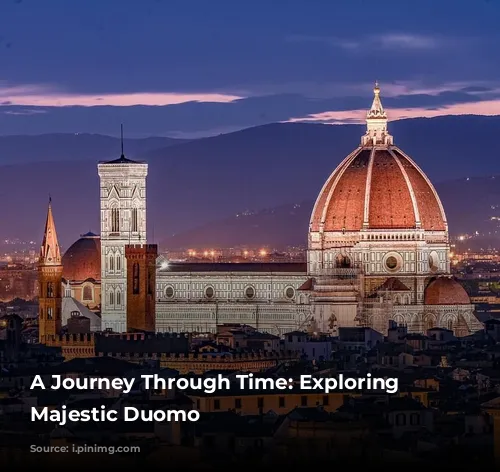Step into the heart of Florence and be transported to a world of art, history, and breathtaking architecture. The Duomo, also known as the Cathedral of Santa Maria del Fiore, stands as a towering testament to the city’s rich past. Its construction, a tale spanning centuries, reflects the evolution of artistic styles and the ambition of a city determined to create a masterpiece.
From Gothic Beginnings to Renaissance Glory
The Duomo’s story begins in the late 13th century, when the renowned architect and sculptor Arnolfo di Cambio laid the first stones. His vision, inspired by the Gothic style, envisioned a cathedral with a grand nave, two side aisles, and a striking rear apse.
However, di Cambio’s passing in 1302 brought construction to a halt. It wasn’t until 1334 that the project was resurrected, this time under the guidance of Giotto, who designed the iconic bell tower known as the Campanile. Sadly, Giotto’s own death in 1337 once again interrupted the construction.
Undeterred, the city entrusted the project to Andrea Pisano and Francesco Talenti, who finally completed the cathedral in 1359. The Campanile, towering 85 meters high, stands as a testament to Giotto’s genius. A climb to its summit, traversing 414 steps, rewards you with panoramic views of Florence that will leave you breathless.
A Symphony of Marble and Renaissance Masterminds
As the 14th century progressed, Florentine artists began to move away from the Gothic style, embracing the emerging Renaissance spirit. The Duomo’s exterior, originally conceived in the Gothic tradition, was transformed by the use of colorful marble, blending the rich red of Siena, the pristine white of Carrara, and the verdant green of Prato. This striking palette gave the cathedral a truly unique and magnificent presence.
The completion of the Duomo fell to two of the Renaissance’s most celebrated figures: Lorenzo Ghiberti and Filippo Brunelleschi. Ghiberti, a master metalsmith, adorned the cathedral with intricate sculptures, while Brunelleschi, an innovative architect and sculptor, took on the monumental task of constructing the dome.
The Dome: A Symbol of Renaissance Ambition
Brunelleschi’s dome was a groundbreaking feat of engineering. Building upon the polygonal base already in place, he embarked on a project that would make the Florentine Cathedral the largest in the world. The red dome, a symbol of Florence itself, rose to a height of 100 meters, with a diameter of 45 meters, a testament to the ambition and ingenuity of the Renaissance.
The Duomo Today: A Monument of Faith and Artistic Genius
The Duomo of Florence, a monument of faith and artistic brilliance, is the episcopal seat of the Archdiocese of Florence. It stands as a testament to the power and wealth of the Tuscan capital during the 13th and 14th centuries. Its name, derived from the lily, Florence’s symbol, reflects the city’s enduring legacy.
Today, the Duomo remains one of the largest churches in Christianity, surpassed only by the Basilica of St. Peter in Vatican City, St. Paul’s Cathedral in London, the Cathedral of Seville, and the Cathedral of Milan. Though its size is surpassed, the Duomo’s historical significance and architectural splendor remain unparalleled.
A Legacy of Excellence: Exploring the Duomo
Visiting the Duomo is an experience that will forever remain etched in your memory. The cathedral itself is free to enter, offering visitors the chance to marvel at its intricate details and soaring arches. To truly delve into the wonders preserved within its walls, consider booking a guided tour. These tours will lead you through the cathedral’s history, unveiling its hidden secrets and the stories behind its masterful creations.
For those seeking a truly immersive experience, consider venturing beyond the cathedral’s walls. The Duomo Complex, encompassing the Battistero (Baptistery of St. John), Giotto’s Campanile, and the Opera del Duomo Museum, offers a captivating journey through the history of Florentine art and architecture.
The Duomo of Florence is more than just a church; it is a living testament to human ingenuity, artistic passion, and enduring faith. It stands as a beacon of inspiration, inviting visitors to explore its depths and experience the soul of Florence.
